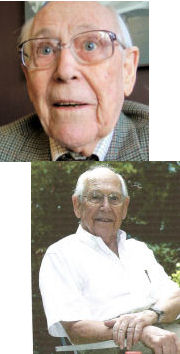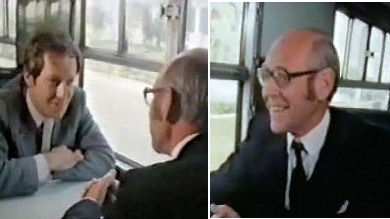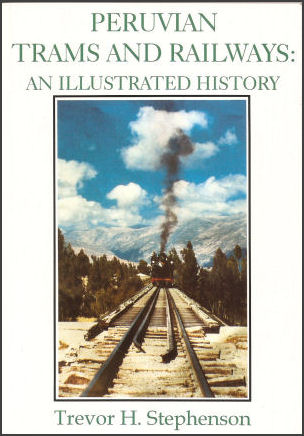Reminiscences
of my 60 years in South America | ||||||||||||||||||||||||||||
| ||||||||||||||||||||||||||||
Epilogue
- back in England 1990-2012 | ||||||||||||||||||||||||||||
Three Miles High 1980 " What do you sell " … "Ohh… lots of things … hook-and-eye tape for bras … battleships" Pause . "Have you sold any battleships recently " And as quick as a flash "No .. but I'm hoping to". The story is in Chapter 17. Miles died in 2008. Trevor was, and still is never short of a good story. We met at a West London hotel in January 2012 when he was packing to return to Peru. He was pulling a roll-on hand luggage case " would you like to see my book - and my collection of memorabilia " The case was full. Two hours rolled by non-stop. I filmed and he talked. All I could say was "What an extraordinary life " And later as I compiled chapter after chapter I knew it was a story that could never be repeated. So how did it end? Was retirement in Britain the final chapter? Trevor explained "
In 1995 having spent five pleasant years in England, I decided to set up my own
business. Previously in March 1994 the London Chamber of Commerce asked me to
head a Trade Mission to Lima. Back in Lima we met the British Ambassador to Peru
who held a reception for several Peruvian Ministers and businessmen. I was also
at the Peruvian Foreign Office to witness the signing of a Trade Agreement. We
also went to see the President Fujimori when I took the opportunity to speak to
him railway matters one of which was that he should combine the Ferrocarril Central
with the Cerro de Pasco Railway thus avoiding duplication of the running and repairs
to the rolling stock
Having
sent a number of students to England on the CBI Scholarship scheme, I decided
that I had better call on Keith Newlands to discuss how things were doing. He
explained how arrangements were made over here when students arrived etc. He then
suggested that I meet the Chairman, Digby Jones (now Baron Jones of Birmingham)
. He received me and congratulated me on my work saying that Peru was the second
country after Australia in the number of students sent to the UK as well upon
my having set up the CBI ex-Students Association in Lima. He also told me that
I was the only sole representative of the CBI in the world as all the others were
firms. He then presented me with a box containing a pair of silver cuff-links
engraved C.BI. A new railway line - a proposal The line to link the town of Huancavelica and the city of Ayacucho in the Andean highlands had been talked about for years. So I persuaded tge government to set up a commission to see if it could be viable. We set off from Huancayo where I had great memories of meeting Helena. We stopped constantly to check the path of the train, its condition and width. At each viaduct we got out and walked a few steps on to it, something which I was not too happy about seeing the river way below us. We arrived at one of the stations where we got off, had a snack of something at a small restaurant, then boarded a train which had just arrived and travelled to Huancavelica. Here the engineer stopped a taxi which took us to Ayacucho, We were taking note of where the track might go. At Ayacucho we went to the Tourist Hotel. Glasses of coca were on a table for tourists to drink at their leisure. Back in London and poor health In 2005 disaster struck. Helena had been suffering for some time from a pain in her left eye. The doctor who was treating her said it was glaucoma but that the pain could be reduced by use of certain drops. These gave the due effect. Then one day, the doctor announced that he was being transferred to Birmingham Hospital. He told her to continue using the drops. I now had to look more after my wife who had difficulty in moving around. I could not leave her for long alone. As a result I decided to stop working and travelling to Peru. I closed down my private firm and from now on, I only attended to the occasional request from my son Andrew. A second disaster The second disaster occurred in December 2006. I had been coughing a lot and two days before Christmas I ' phoned our doctor. He was not able to come to see me but suggested I took an antibiotic. I said I could not go out myself and nor could my wife so he 'phoned a chemist who sent me a cough mixture and the antibiotic. We were now running out of food. Our neighbours, Mark and Julie, kindly bought some food for us. We were supposed to go to Barbara's for Christmas but had to cancel.
As the year progressed we found it more and more difficult to continue. Our savings were almost exhausted and to make it worse, Helena had developed cataract in her right eye and was having more and more difficulty in seeing. What with doing all the purchases, cooking even with packed food from Marks & Spencers, washing up and tidying up the flat, by afternoon I was becoming very tired. Finally it was decided that Helena should have her cataract removed. It was successful but what with increased macula degeneration it was becoming almost impossible for her to read, watch TV or move around, except very slowly and with a stick. We decided we could no longer remain in London and t o live with our daughter Barbara in central England would be impossible due to stairs to the upper floor where she had spare rooms . The only option was to return to Peru where we owned a fully furnished flat and which with the sale of our small London flat, we would have enough money to last us till the end of our days. Return to Lima Arrangements were made. We sent some of our so-called 'valuables' to auction. We received almost nothing from the sale. We then made arrangements to send to Lima some of our furniture and belongings bearing in mind that we had a fully furnished flat in Lima. In the end, we had to leave our beds, sofa, arm chair, sideboard, kitchen stove, refrigerator, washing machine and sundry lamps, a wall clock, glasses, pots and pans etc. We were told that nobody would buy such objects so we had to leave them behind. We had to pay £600 for them to be removed! We left our flat on lst March, the day it was sold, and moved to Barbara's until the 14th March when we left by KLM for Lima. And in Peru we expect to remain for the next 10, 20, 30 years until we go to Heaven, hopefully. Trevor Stephenson, Lima 2013 Trevor keeps in touch by e-mail. Helena is virtually blind and unwell. Barbara lives in England and has two children and Andrew in Lima has three. Trevor is still working as a representative for a British based Infrastructure Development Company. He is a Life member of the Phoenix Club in Lima and of the Lima Cricket Club both with long histories dating back to the early days of British business involvement in Peru. The Lima Cricket Club was founded in 1859 and the Phoenix Club in 1879. The extended railway line has never been built, leaving the Peru's central highlands with only road or expensive air connections to the coast.The proposed line would have included an extension to Cusco the ancient Inca city now the magnet for millions of tourists.
| ||||||||||||||||||||||||||||
|


 Whilst
in Lima during my last year, I started to write an Illustrated History of Peruvian
Trams and Railways. I managed to finish it and Roger Bance an old Cranleigh alumnus
very kindly offered to pay the cost of the book being printed. The launch was
held at the Canning Club in London with friends, relatives and business colleagues
including Keith Newlands of the Confederation of British Industry and members
of the Permanent Way Association and others, . I gave a talk about railways in
Peru and afterwards signed copies. Everyone agreed it was a great success.
Whilst
in Lima during my last year, I started to write an Illustrated History of Peruvian
Trams and Railways. I managed to finish it and Roger Bance an old Cranleigh alumnus
very kindly offered to pay the cost of the book being printed. The launch was
held at the Canning Club in London with friends, relatives and business colleagues
including Keith Newlands of the Confederation of British Industry and members
of the Permanent Way Association and others, . I gave a talk about railways in
Peru and afterwards signed copies. Everyone agreed it was a great success. Here
Digby Jones is giving the award to Trevor in 2000
Here
Digby Jones is giving the award to Trevor in 2000